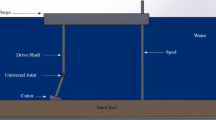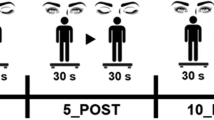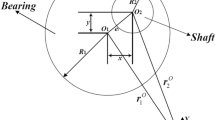Abstract
In curling, a sport played on ice, players release stones on the ice sheet at initial speeds of translation and rotation aiming to a target location with curled trajectory. To elucidate why the stones curl, we focus on the fact that asperities on the leading and trailing parts of the bottom of stone pass through the same spot on the ice surface twice within a short period of time. We also consider the fact that the ice is at a very high temperature close to its melting point and the recovery from the damaged state after the microscopic fracture and plastic deformation by the friction takes place quickly. Theoretical models for the magnitude and direction of the friction force between the stone and ice are developed and the motion of the stone was numerically analysed. Contribution of several factors that may be involved in friction on ice surfaces was investigated in detail. Analysis results were compared with experimental ones in literature and some were found to be in good agreement.









Similar content being viewed by others
Notes
There are similarities and dissimilarities between the mechanical behaviours of ice and metals beyond the elastic limit. Plastic deformation of ice before the fracture is small even under the temperature just below the melting point [23, 24], but dislocations play an important role there [25,26,27,28].
Equation (18) is widely accepted as an expression for the friction coefficient of ice, but theoretical and experimental results on the values of the velocity exponents ξ and μ0 are still controversial. Jensen and Shegelski [16], for example, showed experimentally that ξ = -0.7575 and μ0 = 0.013 when the translational velocity is sufficiently small compared to the rotational velocity. Yasutome et al. [29] investigated ice-to-ice motion without rotation for a velocity range of 10–4 to 10–1 m/s. They found that ξ ≈ − 0.675 for ice temperatures of -5˚C and velocities between 10–2 and 10–1 m/s, and that the coefficient of friction was constant for velocities below 10–2 m/s. Penner [17] showed theoretically that ξ = − 0.5, and in this paper, we assume this value for simplicity. Also, in the present study, the leading and trailing part of the stone are assumed to have different values of μ0 as described in Sect. 2.3. The average value of μ0 over the entire stone studied in this paper ranges from 0.005 to 0.012.
See Appendix as for the dimension of μ0.
References
Nyberg, H., Affredson, S., Hogmark, S., Jacobson, S.: The asymmetrical friction mechanism that puts the curl in the curling stone. Wear 301, 583–589 (2013). https://doi.org/10.1016/j.wear.2015.04.015
Honkanen, V., Ovaska, M., Alava, M.J., Laurson, L., Tuononen, A.J.: A surface topography analysis of the curling stone curl mechanism. Sci. Rep. 8, 1–8 (2018). https://doi.org/10.1038/s41598-018-26595-y
Yanagi, S., Shikano, D., Kameda, T., Harada, Y., Sado, K.: Measurement of pebble’s shape on ice with replica made of the light-curing-resin. In: Proc. JSSI &JSSE Joint Conf. 2019. The Japanese Society of Snow and Ice, Yamagata (2019)
Nyberg, H., Hogmark, S., Jacobson, S.: Calculated trajectories of curling stones sliding under asymmetrical friction: validation of published models. Tribol. Lett. 50, 379–385 (2013). https://doi.org/10.1007/s11249-013-0135-9
Shegelski, M.R.A., Jensen, E.T., Reid, M.: Comment on the asymmetrical friction mechanism that puts the curl in the curling stone. Wear 336–337, 69–71 (2015). https://doi.org/10.1016/j.wear.2015.04.015
Lozowski, E.P., Maw, S., Morris, A., Poirier, L., Kleiner, B., Szilder, K., Maw, S., Morris, A., Poirier, L., Kleiner, B.: Towards a First Principles Model of Curling Ice Friction and Curling Stone Dynamics. In: 25th Int. Ocean and Polar Engineering Conf. (pp. 1730–1738) (2015)
Kameda, T., Shikano, D., Harada, Y., Yanagi, S., Sado, K.: The importance of the surface roughness and running band area on the bottom of a stone for the curling phenomenon. Sci. Rep. 10, 1–9 (2020). https://doi.org/10.1038/s41598-020-76660-8
Penner, A.R.: A Scratch-guide model for the motion of a curling rock. Tribol. Lett. 67, 1–13 (2019). https://doi.org/10.1007/s11249-019-1144-0
Ohashi, T.: Dislocation density-based modeling of crystal plasticity finite element analysis. In: Handbook of mechanics of materials, pp. 1–26. Springer Nature Singapore Pte Ltd., Singapore (2018)
Humphreys, F.J., Hatherly, M.: Recrystallization and related annealing phenomena. Elsevier Science Ltd, Oxford (1996)
Ramseier, R.O., Keeler, C.M.: The sintering process in snow. J. Glaciol. 6, 421–424 (1966). https://doi.org/10.3189/s0022143000019535
Maeno, N.: Curl mechanism of a curling stone on ice pebbles. Bull. Glaciol. Res. 28, 1–6 (2010). https://doi.org/10.5331/bgr.28.1
Rivera-Díaz-Del-Castillo, P.E.J., Huang, M.: Dislocation annihilation in plastic deformation: i multiscale irreversible thermodynamics. Acta Mater. 60, 2606–2614 (2012). https://doi.org/10.1016/j.actamat.2012.01.027
Maeno, N.: Curling. In: Braghin, F., Cheli, F., Maldifassi, S., Melzi, S., Sabbioni, E. (eds.) The Engineering Approach to Winter Sports, pp. 327–347. Springer, New York, NY (2016). https://doi.org/10.1007/978-1-4939-3020-3
Shegelski, M.R.A., Niebergall, R., Walton, M.A.: The motion of a curling rock. Can. J. Phys. 74, 663–670 (1996). https://doi.org/10.1139/p96-095
Jensen, E.T., Shegelski, M.R.R.A.: The motion of curling rocks: experimental investigation and semi-phenomenological description. Can. J. Phys. 82, 791–809 (2004). https://doi.org/10.1139/P04-020
Penner, A.R.: The physics of sliding cylinders and curling rocks. Am. J. Phys. 69, 332–339 (2001). https://doi.org/10.1119/1.1309519
Wikipedia: Leapfrog integration. Available at https://en.wikipedia.org/wiki/Leapfrog_integration#cite_ref-2. (2021)
Lozowski, E., Maw, S., Kleiner, B., Szilder, K., Shegelski, M., Musilek, P., Ferguson, D.: Comparison of IMU measurements of curling stone dynamics with a numerical model. Procedia Eng. 147, 596–601 (2016). https://doi.org/10.1016/j.proeng.2016.06.246
Pondicherry, K., Rajaraman, D., Galle, T., Hertelé, S., Fauconnier, D., De Baets, P.: optimization and validation of a load-controlled numerical model for single asperity scratch. Tribol. Lett. 68, 1–13 (2020). https://doi.org/10.1007/s11249-020-1283-3
Eder, S.J., Grützmacher, P.G., Rodríguez Ripoll, M., Belak, J.F.: Elucidating the onset of plasticity in sliding contacts using differential computational orientation tomography. Tribol. Lett. 69, 1–15 (2021). https://doi.org/10.1007/s11249-021-01451-9
Akoussan, K., Nouari, M., Moufki, A., Nouari, M.: Modeling of the tribological behavior of materials using crystal plasticity constitutive model effect of heat partition and friction. Tribol. Lett. 69, 109–110 (2021). https://doi.org/10.1007/s11249-021-01484-0
Schulson, E.M.: The Structure and Mechanical Behavior of Ice. JOM. 51, 21–27 (1999). https://doi.org/10.1177/004051755102100302
von Bock und Polach, R.U.F.: The mechanical behavior of model-scale ice: experiments, numerical modeling and scalability, Available at http://urn.fi/URN:ISBN:978-952-60-6823-7, (2016)
Devincre, B.: Dislocation dynamics simulations of slip systems interactions and forest strengthening in ice single crystal. Philos. Mag. 93, 235–246 (2013). https://doi.org/10.1080/14786435.2012.699689
Wei, Y., Dempsey, J.P.: Dislocation motion and plasticity of ice. In: IAHR ice symposium 1992, pp. 1100–1114. International Association for Hydraulic Research, Banff (1992)
Cole, D.M., Durell, G.D.: A dislocation-based analysis of strain history effects in ice. Philos. Mag. A. 81, 1849–1872 (2001). https://doi.org/10.1080/01418610108216640
Higashi, A., Koinuma, S., Mae, S.: plastic yielding in ice single crystals. Jpn. J. Appl. Phys. 3, 610–616 (1964). https://doi.org/10.1143/JJAP.3.610
Yasutome, A., Arakawa, M., Maeno, N.: Measurements of ice-ice friction coefficients. J. Japanese Soc. Snow Ice. 61, 437–443 (1999). https://doi.org/10.5331/seppyo.61.437
Acknowledgements
Dr. Takao Kameda and Dr. Yasuhiro Harada at Kitami Institute of Technology are acknowledged for their helpful discussion on this work.
Funding
This research did not receive any specific grant form funding agencies in the public, commercial or not-for-profit sectors.
Author information
Authors and Affiliations
Contributions
The author TO contributed to the study conception and design. Material preparation, data collection and analysis were also performed by the author.
Corresponding author
Ethics declarations
Competing interest
The author (Tetsuya Ohashi) has no relevant financial or non-financial interests to disclose.
Additional information
Publisher's Note
Springer Nature remains neutral with regard to jurisdictional claims in published maps and institutional affiliations.
Appendices
Appendix
Motion of a non-rotating stone
When the stone is not rotating, the equation of motion for the stone is
where m, y and v are the mass, position and velocity of the stone, respectively. μ is the dimensionless coefficient of kinetic friction and written as follows:
The pre-factor μ0 of the kinetic friction coefficient is a function of temperature, pressure, etc., and the dimension is m−ξsξ. Experimental studies have shown that the velocity exponent ξ is roughly − 1 ≤ ξ ≤ − 0.5. Integrating Eq. (38), we obtain
where v0 is the initial velocity. Let tstop be the time at which the stone stops its motion. We have from v = 0,
The travel distance is calculated by integrating Eq. (41) and given by
The distance ystop after the stone stops the movement is
where, v0 is the initial velocity. When ξ = − 0.5, ystop is
Rights and permissions
Springer Nature or its licensor holds exclusive rights to this article under a publishing agreement with the author(s) or other rightsholder(s); author self-archiving of the accepted manuscript version of this article is solely governed by the terms of such publishing agreement and applicable law.
About this article
Cite this article
Ohashi, T. Why Curling Stones Curl: Modelling and Numerical Experiments. Tribol Lett 70, 107 (2022). https://doi.org/10.1007/s11249-022-01648-6
Received:
Accepted:
Published:
DOI: https://doi.org/10.1007/s11249-022-01648-6




